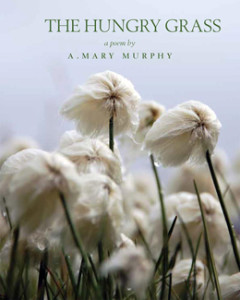A. Mary Murphy’s The Hungry Grass is gorgeous. It sweeps me up with its vivid images. It has altered, forever, my ideas about the Irish potato famine and those who lived through it, died in it, or fled it. Gone are the dry, two sentence descriptions of faceless Irish I was given in school texts. Murphy has given me something so much better. She has given me history wrapped in art and craft. She has brought these people and their world to life. 
The book length poem is 2295 lines, each with seven syllables. I don’t pretend to understand poets and what would possess a person to submit themselves to such a strict form; I only enjoy the incredible result. Murphy mixes Irish dialect with English and seamlessly embeds meticulously researched details into the work which describes fifteen years in the lives of her ancestors. In the first pages, we see the life of Irish Tenant families before the famine, carried through each season with its particularities, its work, its religious observances, and its customs until a full year passes. Life before the famine is hardscrabble but it is also full of joy. The narrator marries in the spring and by the next spring, gives birth to a child, her little life so precarious and precious. The reader knows what the stakes are here. Love is love, whether it is in 1834 or 2016. And so is hunger.
Although the details place us firmly in the Irish potato famine, the poem’s richness cannot help but tie it thematically to all famines, all mass migrations, all displacements, all droughts, and all victims of soulless and intransigent governments.
The poem starts, “And it is how it happened / before fields of hungry grass / grew up over all the world / pinching us with starvation” and I am hooked. “Pinching” is such an excellent verb to attach to “starvation.” I feel it in my body, in my stomach. I read on and am shown the thousand-year churchyard, the neeps and nettles, the furrows in the soil ready for planting, the Liecester rams, cormorants, perch and corncrakes crying in the meadow and even a trespassing goose. I am fully immersed in this world of the past and given a close up view as it falls apart.
I was fortunate to hear Murphy read from this book last week at an Inanna Publications event at Owl’s Nest Books in Calgary. Hearing her read, hearing the lilt of the Irish, and experiencing the flow of the language coming seven syllables at a time was a delight. Murphy makes use of all the senses to put us in this time and place. I hear the birds and feel the breeze. I am, like Murphy was during her research, in the bog. And I am hungry.
Thank you for this book, A. Mary Murphy. This is art.
